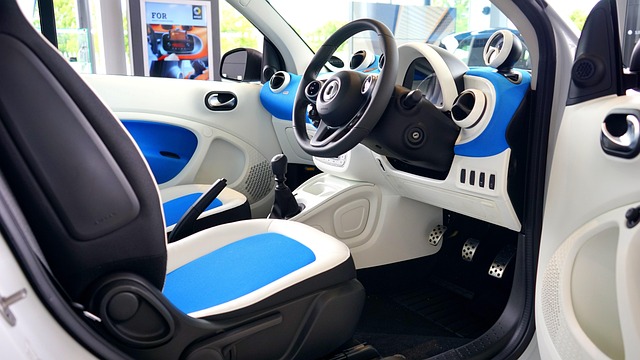EV charging stations have evolved significantly, driven by advancements in connectivity and V2I communication (Select Smart Car Tech). Integrations like speech recognition technology enable hands-free interactions. Autonomous navigation systems streamline recharging during long trips, enhancing the EV ownership experience. These innovations showcase the pursuit of intuitive and accessible Smart Car Tech, transforming stations into sophisticated hubs within smart cities for efficient resource management. Critical components include dynamic maps displaying station locations, availability, power outputs, and accepted payment methods. Integrated mobile apps, real-time data, and AI enhance user experiences through diagnostics synchronization, blind spot detection, and smart parking assistance. Real-time data analysis contributes to infrastructure planning and driver safety innovations. The future holds seamless charging experiences through advanced digital maps tailored for EV models, with features like automatic garage openings and adaptive cruise control.
“Unleash the potential of electric vehicles (EVs) with a comprehensive understanding of charging infrastructure. This article explores the critical role of EV charging stations, tracing their evolution from basic necessities to advanced smart car tech integrations. We delve into key components essential for an efficient network and highlight the immense benefits of mapping these stations.
Discover how real-time data integration enhances user experiences, and glimpse into the future trends shaping the way we navigate and interact with EV charging maps, powered by select smart car tech innovations.”
- Understanding Electric Vehicle (EV) Charging Stations
- The Evolution of Smart Car Tech in Charging Infrastructure
- Key Components of an Efficient EV Charging Network
- Benefits of Using a Map for EV Charging Station Locations
- Integrating Real-Time Data for Seamless Charging Experiences
- Future Trends: Enhancing the EV Charging Map Experience
Understanding Electric Vehicle (EV) Charging Stations

Electric Vehicle (EV) charging stations have become a vital component of sustainable transportation infrastructure. These stations provide the essential power source for electric cars, allowing them to recharge quickly and efficiently. Understanding the tech behind these stations is crucial when considering the future of green mobility. Modern EV charging solutions offer various options, from Level 1 (standard household outlets) to faster Level 2 and DC fast-charging networks. This evolution has been driven by advancements in car connectivity solutions and vehicle-to-infrastructure (V2I) communication technologies.
One notable development is the integration of speech recognition technology into charging stations, enabling users to interact with them hands-free while their vehicles charge. Additionally, autonomous vehicle navigation systems can leverage these charging points for seamless recharging during long-distance journeys, further enhancing the overall EV ownership experience. Such innovations highlight the continuous efforts to make electric car tech more intuitive and accessible.
The Evolution of Smart Car Tech in Charging Infrastructure

The evolution of smart car technology has revolutionized the way we interact with our vehicles and their charging infrastructure. With advancements in connectivity and automation, modern electric vehicle (EV) charging stations are no longer mere outlets for battery replenishment but sophisticated hubs integrated into the fabric of smart cities. These stations leverage Select Smart Car Tech to offer a range of enhanced features, from self-driving capabilities that ease parking and charging processes to personalized driver profiles that tailor charging plans based on individual usage patterns.
Moreover, smart city integration ensures that these charging stations become integral parts of an efficient logistics network. Real-time tracking and management solutions enable optimal utilization of resources, reducing wait times for EV owners while providing valuable data for improving urban mobility. The integration of advanced technologies not only enhances the convenience and efficiency of EV charging but also positions these cities as pioneers in sustainable transportation, setting a precedent for future smart city developments that prioritize both environmental consciousness and technological innovation.
Key Components of an Efficient EV Charging Network

An efficient Electric Vehicle (EV) charging network relies on several key components to ensure a seamless and convenient experience for electric car owners. Firstly, the map itself is pivotal; it should be up-to-date, comprehensive, and user-friendly, displaying not just charging stations but also relevant details like station availability, power output, and payment methods accepted. This is where Select Smart Car Tech comes into play, offering dynamic mapping solutions that integrate real-time data for an accurate view of the EV charging landscape.
Moreover, smart home integration and AI in the automotive industry are transforming how we interact with these networks. Features like lane departure warnings can be integrated into navigation systems, guiding drivers to available charging stations along their route while ensuring safe driving incentives. Such advancements not only make long-distance travel more manageable for EV owners but also contribute to a greener future by encouraging wider adoption of electric vehicles.
Benefits of Using a Map for EV Charging Station Locations

Using a map tailored for electric vehicle (EV) charging station locations offers numerous advantages for eco-friendly smart car owners. Such maps provide real-time data on nearby charging points, helping drivers plan their journeys more efficiently and reducing range anxiety. With just a glance, users can identify conveniently located stations, saving them time and effort in searching for charging options during their daily commutes or long-distance travel.
Moreover, these maps often integrate with mobile apps that go beyond simple navigation. They enable synchronization of vehicle diagnostics monitoring, providing drivers with valuable insights into their EV’s performance. Additionally, some advanced systems incorporate blind spot detection sensors and smart parking assistance, enhancing overall driving experience and contributing to a more sustainable future through the promotion of green transportation.
Integrating Real-Time Data for Seamless Charging Experiences

In today’s digital era, integrating real-time data is a game-changer for electric vehicle (EV) owners seeking seamless charging experiences. By utilizing advanced Select Smart Car Tech, charging stations can provide up-to-date information on availability and even predict demand patterns. This ensures that drivers access fully charged stations without the hassle of finding empty spots. Real-time data also enables users to adopt low-impact driving techniques by planning routes with optimal charging stops, enhancing overall fuel efficiency optimization.
Moreover, these tech advancements go beyond convenience; they contribute to hybrid technology improvements and driver safety innovations. For instance, smart charging maps can notify drivers of nearby stations equipped with keyless entry systems, reducing the need for physical interaction during low-light or adverse weather conditions. Additionally, real-time data analysis helps identify charging hotspots and plan infrastructure upgrades, fostering a more extensive and efficient network that supports the growing adoption of hybrid and fully electric vehicles.
Future Trends: Enhancing the EV Charging Map Experience

The future of electric vehicle (EV) charging maps looks set to be a seamless and efficient experience for drivers transitioning to low-emission vehicles. With advancements in smart car tech, we can expect more interactive and real-time mapping solutions. Imagine being able to navigate not just roads but also a digital tapestry of charging stations, tailored to your specific EV model and battery capacity. This technology will provide drivers with the peace of mind to embark on longer journeys, knowing exactly where to find fast-charging stations along their route.
One trend to watch is the integration of automatic garage opening systems and adaptive cruise control into these maps. Such innovations not only enhance convenience but also contribute to a smoother driving experience, reducing driver stress during charging stops. As the network of charging infrastructure expands, so too will the options for drivers, making EV ownership more accessible and appealing.
As we look towards an increasingly electric future, a comprehensive and up-to-date map of charging stations becomes indispensable. Integrating real-time data through advanced Select Smart Car Tech ensures drivers can navigate their journeys with ease, enhancing the overall EV charging experience. By focusing on efficient network infrastructure and leveraging innovative solutions, we can create a seamless and accessible network for all electric vehicle owners, encouraging wider adoption of sustainable transportation.
